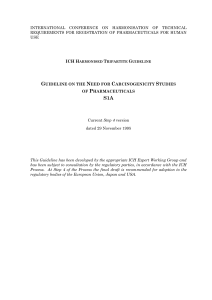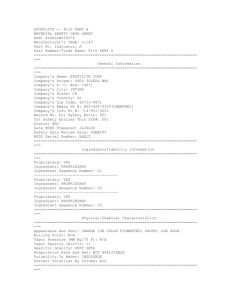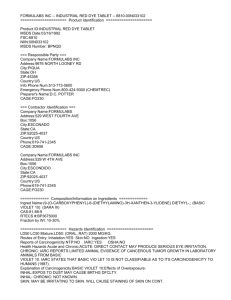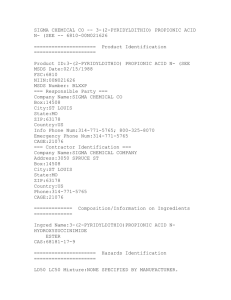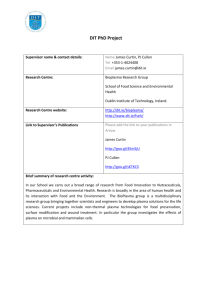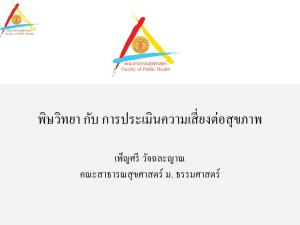TESTING FOR CARCINOGENICITY OF PHARMACEUTICALS
advertisement
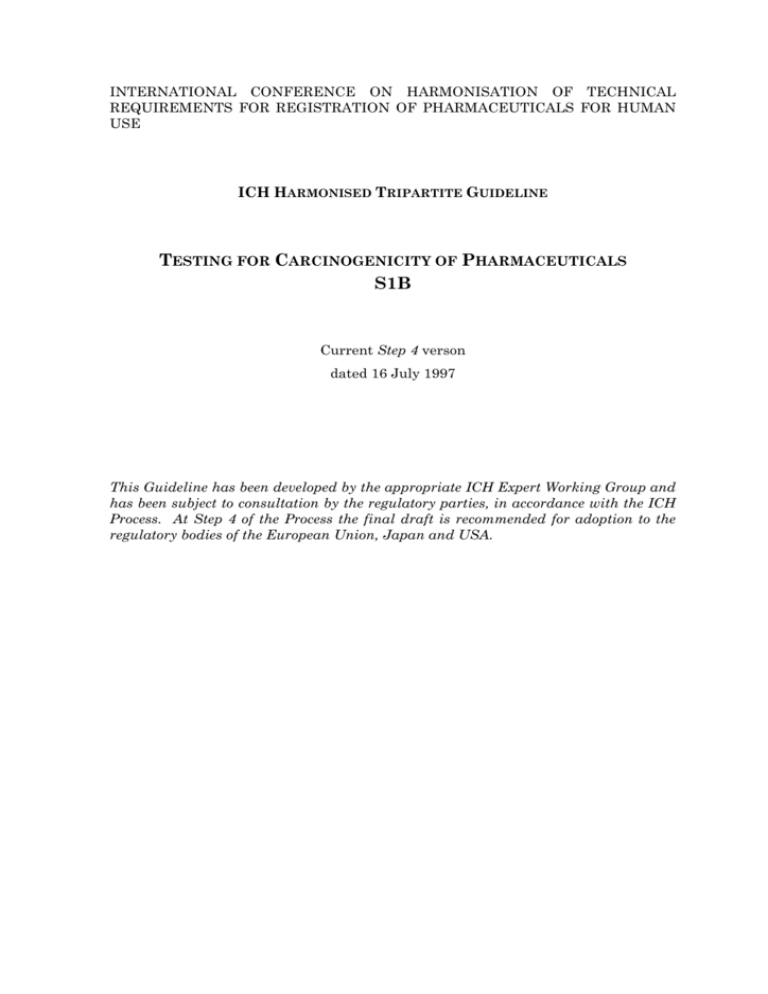
INTERNATIONAL CONFERENCE ON HARMONISATION OF TECHNICAL REQUIREMENTS FOR REGISTRATION OF PHARMACEUTICALS FOR HUMAN USE ICH HARMONISED TRIPARTITE GUIDELINE TESTING FOR CARCINOGENICITY OF PHARMACEUTICALS S1B Current Step 4 verson dated 16 July 1997 This Guideline has been developed by the appropriate ICH Expert Working Group and has been subject to consultation by the regulatory parties, in accordance with the ICH Process. At Step 4 of the Process the final draft is recommended for adoption to the regulatory bodies of the European Union, Japan and USA. S1B Document History First Codification S1B New Codification History Date Approval by the Steering Committee under Step 2 and release for public consultation. 1 May 1996 S1B 16 July 1997 S1B November 2005 Current Step 4 version S1B Approval by the Steering Committee under Step 4 and recommendation for adoption to the three ICH regulatory bodies. TESTING FOR CARCINOGENICITY OF PHARMACEUTICALS ICH Harmonised Tripartite Guideline Having reached Step 4 of the ICH Process at the ICH Steering Committee meeting on 16 July 1997, this guideline is recommended for adoption to the three regulatory parties to ICH TABLE OF CONTENTS 1. OBJECTIVE ........................................................................................................... 1 2. BACKGROUND ..................................................................................................... 1 3. SCOPE OF THE GUIDELINE ............................................................................. 2 4. THE GUIDELINE .................................................................................................. 2 5. 6. 7. 4.1 Preamble. ....................................................................................................... 2 4.2 Experimental approaches to testing for carcinogenic potential. .................. 2 4.2.1 Choice of species for a long-term carcinogenicity study. ................... 2 4.2.2 Additional in vivo tests for carcinogenicity. ...................................... 2 4.2.3 Considerations in the choice of short or medium term tests for carcinogenicity. ................................................................................... 3 MECHANISTIC STUDIES ................................................................................... 3 5.1 Cellular changes. ........................................................................................... 3 5.2. Biochemical measurements. .......................................................................... 3 5.3. Considerations for additional genotoxicity testing ...................................... 3 5.4. Modified protocols. ......................................................................................... 4 GENERAL CONSIDERATIONS IN THE CHOICE OF AN APPROPRIATE SPECIES FOR LONG TERM CARCINOGENICITY TESTING ..................... 4 6.1. Information from surveys on pharmaceuticals. ............................................ 4 6.2. Potential to study mechanisms. .................................................................... 4 6.3. Metabolic disposition. .................................................................................... 5 6.4. Practicality. .................................................................................................... 5 6.5. Testing in more than one species. ................................................................. 5 6.6. Exceptions. ..................................................................................................... 5 EVALUATION OF CARCINOGENIC POTENTIAL. ........................................ 5 NOTES ............................................................................................................................ 6 ANNEX: Other ICH Guidelines Cited ...................................................................... 7 i TESTING FOR CARCINOGENICITY OF PHARMACEUTICALS 1. OBJECTIVE This document provides guidance on approaches for evaluating the carcinogenic potential of pharmaceuticals. 2. BACKGROUND Historically, the regulatory requirements for the assessment of the carcinogenic potential of pharmaceuticals in the three regions (E.U., Japan, U.S.) provided for the conduct of long-term carcinogenicity studies in two rodent species, usually the rat and the mouse. Given the cost of these studies and their extensive use of animals, it is in keeping with the mission of ICH to examine whether this practice requiring long term carcinogenicity studies in two species could be reduced without compromising human safety. This guideline should be read in conjunction with other guidelines (see Annex), especially: S1.A: Guideline on the Need for Carcinogenicity Studies of Pharmaceuticals. S1.C: Dose Selection for Carcinogenicity Studies of Pharmaceuticals. Long-term rodent carcinogenicity studies for assessing the carcinogenic potential of chemicals (including pharmaceuticals) to humans are currently receiving critical examination. Since the early 1970's, many investigations have shown that it is possible to provoke a carcinogenic response in rodents by a diversity of experimental procedures, some of which are now considered to have little or no relevance for human risk assessment. This guideline outlines experimental approaches to the evaluation of carcinogenic potential that may obviate the necessity for the routine conduct of two long-term rodent carcinogenicity studies for those pharmaceuticals that need such evaluation. The relative individual contribution of rat and mouse carcinogenicity studies and whether the use of rats or mice alone would result in a significant loss of information on carcinogenicity relevant to human risk assessment has been addressed by six surveys of the data for human pharmaceuticals. The surveys were those of the International Agency for Research on Cancer (IARC), the U.S. Food and Drug Administration (FDA), the U.S. Physicians’ Desk Reference (PDR), the Japanese Pharmaceutical Manufacturers’ Association (JPMA), the EU Committee for Proprietary Medicinal Products (CPMP), and the UK Centre for Medicines Research (CMR). The dimensions of these surveys and the principal conclusions of the analyses can be found in the Proceedings of the Third International Conference (1995) on Harmonization. Positive results in long-term carcinogenicity studies that are not relevant to the therapeutic use of a pharmaceutical present a dilemma to all parties: regulatory reviewers, companies developing drugs and the public at large. The conduct of one long-term carcinogenicity study (rather than two long term studies) would, in part, allow resources to be diverted to other approaches to uncover potential carcinogenicity relevant to humans. A “weight of evidence” approach, that is use of scientific judgment in evaluation of the totality of the data derived from one longterm carcinogenicity study along with other appropriate experimental investigations, enhances the assessment of carcinogenic risk to humans. 1 Testing for Carcinogenicity of Pharmaceuticals 3. SCOPE OF THE GUIDELINE The guideline embraces all pharmaceutical agents that need carcinogenicity testing as indicated in Guideline S1A. For biotechnology-derived pharmaceuticals refer to Guideline S6. 4. THE GUIDELINE 4.1 Preamble. The strategy for testing the carcinogenic potential of a pharmaceutical is developed only after the acquisition of certain key units of information, including the results of genetic toxicology (Guidelines S2A and S2B), intended patient population, clinical dosage regimen (Guideline S1A), pharmacodynamics in animals and in humans (selectivity, dose-response) (Guideline S1C), and repeated-dose toxicology studies. Repeated-dose toxicology studies in any species (including nonrodents) may indicate that the test compound possesses immunosuppressant properties, hormonal activity, or other activity considered to be a risk factor for humans, and this information should be considered in the design of any further studies for the assessment of carcinogenic potential (see also Note 1). 4.2 Experimental approaches to testing for carcinogenic potential. Flexibility and judgment should be exercised in the choice of an approach which should be influenced by the information cited in the above preamble. Given the complexity of the process of carcinogenesis, no single experimental approach can be expected to predict the carcinogenic potential of all pharmaceuticals for humans. The basic principle: The basic scheme comprises one long-term rodent carcinogenicity study, plus one other study of the type mentioned in §4.2.2 that supplements the long term carcinogenicity study and provides additional information that is not readily available from the long term assay. 4.2.1 Choice of species for a long-term carcinogenicity study. The species selected should be appropriate, based on considerations that include the following: (a) Pharmacology. (b) Repeated-dose toxicology. (c) Metabolism (see also Guidelines S1C and S3A). (d) Toxicokinetics (see also Guidelines S1C, S3A, and S3B). (e) Route of administration (e.g., less common routes such as dermal and inhalation). In the absence of clear evidence favoring one species, it is recommended that the rat be selected. This view is based on the factors discussed in §6. 4.2.2 Additional in vivo tests for carcinogenicity. Additional tests may be either (a) or (b) (see Note 2). (a) Short or medium-term in vivo rodent test systems. Possibilities should focus on the use of in vivo models providing insight into carcinogenic endpoints. These may include models of initiation- 2 Testing for Carcinogenicity of Pharmaceuticals promotion in rodents, or models of carcinogenesis using transgenic or neonatal rodents (Note 3). (b) A long-term carcinogenicity study in a second rodent species is still considered acceptable (see § 4.2.1 for considerations). 4.2.3 Considerations in the choice of short or medium term tests for carcinogenicity. Emphasis should be placed on selection of a test method that can contribute information valuable to the overall “weight of evidence” for the assessment of carcinogenic potential. The rationale for this choice should be documented and based on information available at the time of method selection about the pharmaceutical such as pharmacodynamics and exposure compared to human or any other information that may be relevant. This rationale should include a scientific discussion of the strengths and weaknesses of the method selected for the pharmaceutical(see Note 4). 5. MECHANISTIC STUDIES Mechanistic studies are often useful for the interpretation of tumor findings in a carcinogenicity study and can provide a perspective on their relevance to human risk assessment. The need for or the design of an investigative study will be dictated by the particular properties of the drug and/or the specific results from the carcinogenicity testing. Dose dependency and the relationship to carcinogenicity study conditions should be evaluated in these investigational studies. Suggestions include: 5.1 Cellular changes. Relevant tissues may be examined for changes at the cellular level using morphological, histochemical, or functional criteria. As appropriate, attention may be directed to such changes as the dose-relationships for apoptosis, cell proliferation, liver foci of cellular alteration, or changes in intercellular communication. 5.2. Biochemical measurements. Depending on the putative mode of tumorigenic action, investigations could involve measurements of: plasma hormone levels, e.g. T3/T4, TSH, prolactin growth factors binding to proteins such as 2-globulin tissue enzyme activity, etc. In some situations, it may be possible to test a hypothesis of, for example, a hormone imbalance with another study in which the imbalance has been, at least in part, compensated. 5.3. Considerations for additional genotoxicity testing (see Guidelines S2A and S2B). Additional genotoxicity testing in appropriate models may be invoked for compounds that were negative in the standard test battery but which have shown effects in a carcinogenicity test with no clear evidence for an epigenetic mechanism. Additional testing can include modified conditions for metabolic activation in in vitro tests or can include in vivo tests measuring genotoxic damage in target organs of tumor induction 3 Testing for Carcinogenicity of Pharmaceuticals (e.g., DNA damage and repair tests, 32P-postlabeling, mutation induction in transgenes). 5.4. Modified protocols. Modified protocols may be helpful to clarify the mode of tumorigenic action of the test substance. Such protocols might include groups of animals to explore, for example, the consequence of interrupted dosage regimens, or the reversibility of cellular changes after cessation of dosing. 6. GENERAL CONSIDERATIONS IN THE CHOICE OF AN APPROPRIATE SPECIES FOR LONG TERM CARCINOGENICITY TESTING There are several general considerations which, in the absence of other clear indications, suggest that the rat will normally be the species of choice for a long term carcinogenicity study. 6.1. Information from surveys on pharmaceuticals. In the six analyses, attention was given to data on genetic toxicology, tumor incidence, strain of animal, route and dosage regimen, pharmacological or therapeutic activity, development and/or regulatory status, and, if relevant, reason for termination of development. Inevitably, there was considerable overlap of the data, but that is not necessarily an impediment to drawing valid conclusions. The main overall conclusions from the analysis were: a. Although very few instances have been identified of mouse tumors being the sole reason for regulatory action concerning a pharmaceutical, data from this species may have contributed to a “weight of evidence” decision and in identifying agents that caused tumors in two rodent species. b. Of the compounds displaying carcinogenic activity in only one species, the number of "rat-only" compounds was about double the number of "mouse-only" compounds, implying in a simplistic sense that the rat is more "sensitive" than the mouse. c. As with other surveys accessible in the literature, the data for pharmaceuticals were dominated by the high incidence of rodent liver tumors. The high susceptibility of mouse liver to nongenotoxic chemicals has been the subject of many symposia and workshops. These have concluded that these tumors may not always have relevance to carcinogenic risk in humans and can potentially be misleading. 6.2. Potential to study mechanisms. The carcinogenic activity of nongenotoxic chemicals in rodents is characterized by a high degree of species, strain, and target organ specificity and by the existence of thresholds in the dose-response relationship. Mechanistic studies in recent years have permitted the distinction between effects that are specific to the rodent model and those that are likely to have relevance for humans. Progress has often been associated with increased understanding of species and tissue specificity. For example, receptor-mediated carcinogenesis is being recognized as of growing importance. Most of these advances are being made in the rat, and only rarely in the mouse. 4 Testing for Carcinogenicity of Pharmaceuticals 6.3. Metabolic disposition. Neither rats nor mice would seem, on metabolic grounds, to be a priori generally more suitable for the conduct of long term carcinogenicity studies. However, much attention is now being given to pharmacokinetic-pharmacodynamic relationships and rapid progress is occurring in knowledge of the P-450 isozymes that mediate the biotransformation of drugs. Most of this research activity is confined to rats and humans. Therefore, in the near future at least, where specific information on the P450 isozymes involved in biotransformation is critical for the evaluation it appears that mice would be less likely to provide this mechanistic information. 6.4. Practicality. Pertinent to the above two topics is the question of feasibility of investigative studies. Size considerations alone put the mouse at a severe disadvantage when it comes to the taking of serial blood samples, microsurgery/catheterization, and the weighing of organs. Blood sampling often requires the sacrifice of the animals, with the result that many extra animals may be needed when mice are subject to such investigations. 6.5. Testing in more than one species. Most of the currently available short and medium term in vivo models for carcinogenicity testing involve the use of mice. In order to allow testing in more than one species for carcinogenic potential, when this is considered important and appropriate, the rat will often be used in the long term carcinogenicity study. 6.6. Exceptions. Despite the above considerations, there may be circumstances under which the mouse or another rodent species could be justified on mechanistic, metabolic, or other grounds as being a more appropriate species for the long term carcinogenicity study for human risk assessment (c.f. §4.2.1). Under such circumstances it may still be acceptable to use the mouse as the short term or medium term model. 7. EVALUATION OF CARCINOGENIC POTENTIAL. Evidence of tumorigenic effects of the drug in rodent models should be evaluated in light of the tumor incidence and latency, the pharmacokinetics of the drug in the rodent models as compared to humans, and data from any ancillary or mechanistic studies that are informative with respect to the relevance of the observed effects to humans. The results from any tests cited above should be considered as part of the overall “weight of evidence” taking into account the scientific status of the test systems. 5 Testing for Carcinogenicity of Pharmaceuticals NOTES Note 1. Data from in vitro assays, such as a cell transformation assay, can be useful at the compound selection stage. Note 2. If the findings of a short or long-term carcinogenicity study and of genotoxicity tests and other data indicate that a pharmaceutical clearly poses a carcinogenic hazard to humans, a second carcinogenicity study would not usually be useful. Note 3. Several experimental methods are under investigation to assess their utility in carcinogenicity assessment. Generally, the methods should be based on mechanisms of carcinogenisis that are believed relevant to humans and applicable to human risk assessment. Such studies should supplement the long term carcinogenicity study and provide additional information that is not readily available from the long term assay. There should also be consideration given animal numbers, welfare and the overall economy of the carcinogenic evaluation process. The following is a representative list of some approaches that may meet these criteria and is likely to be revised in the light of further information. (a) The initiation-promotion model in rodent. One initiation-promotion model for the detection of hepatocarcinogens (and modifiers of hepatocarcinogenicity) employs an initiator, followed by several weeks of exposure to the test substance. Another multi-organ carcinogenesis model employs up to five initiators followed by several months of exposure to the test substance. (b) Several transgenic mouse assays including the p53+/- deficient model, the Tg.AC model, the TgHras2 model, the XPA deficient model, etc. (c) The neonatal rodent tumorigenicity model. Note 4. While there may be a number of approaches that will in general meet the criteria described in Note 3 for use as the additional in vivo study, not all may be equally suitable for a particular pharmaceutical. The following are examples of factors that should be considered and addressed in the rationale: 1. Can results from the model provide new information not expected to be available from the long-term study that is informative with respect to hazard identification and/or risk assessment? 2. Can results from the model address concerns related to the carcinogenic process arising from prior knowledge of the pharmaceutical or compounds with similar structures and/or mechanisms of action? These concerns may include genotoxic, mitogenic, promotional, or receptor-mediated effects, etc. 3. Does the metabolism of the pharmaceutical shown in the animal model affect the evaluation of carcinogenic risk for humans? 4. Is adequate systemic or local exposure attained in relation to human exposure? 5. How extensively has the model been evaluated for its intended use? Prior to using any new in vivo methods in testing the carcinogenic potential of pharmaceuticals for humans, it is critical that the method be evaluated for its ability to contribute to the weight of evidence assessment. Many experimental studies are in progress (1997) to evaluate the new short or 6 Testing for Carcinogenicity of Pharmaceuticals medium tests for carcinogenic potential. These include selected pharmaceuticals with known potencies and known mechanism of carcinogenic activity in rodents, and also putative human noncarcinogens. When the results of these studies become available, it may be possible to offer clearer guidance on which of these tests have the most relevance for cancer assessment in humans. ANNEX: Other ICH Guidelines Cited Guideline S2A: Notes for Guidance on Specific Aspects of Regulatory Genotoxicity Tests. Guideline S2B: A Standard Battery of Genotoxicity Testing of Pharmaceuticals. Guideline S3A: Notes for Guidance on Toxicokinetics. The Assessment of Systemic Exposure in Toxicity Studies. Guideline S3B: Guidance on Repeat-Dose Tissue Distribution Studies. Guideline S6: Preclinical Testing of Biotechnology-derived Pharmaceuticals. 7
